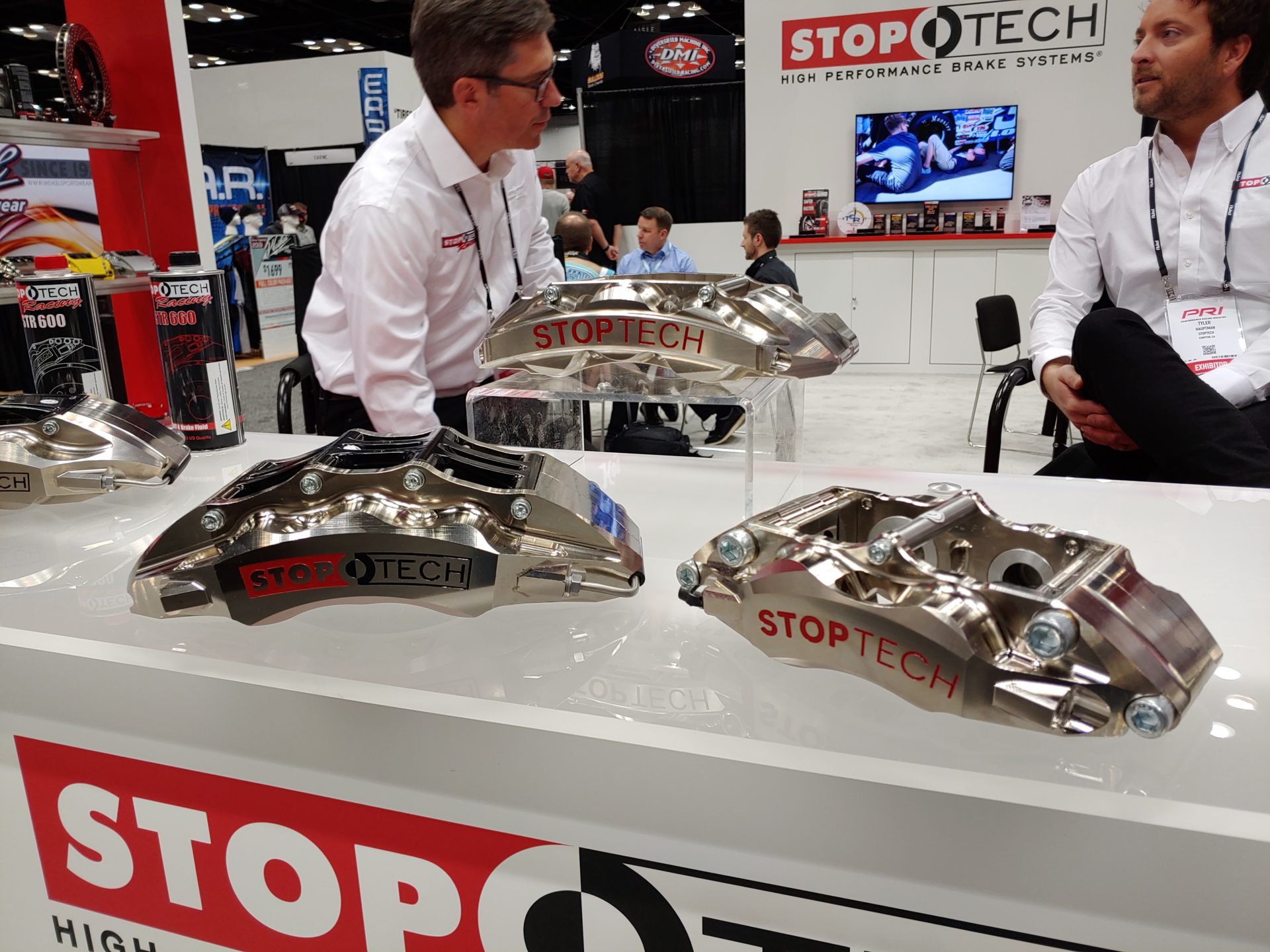
The new G4X line features an upgraded microcontroller and communications chip at its core. This combination allows for much faster data transfer of the expanded 512MB of logging data, which is now capable of having up to 250 channels recorded.
While the full line of stand-alone Link ECUs is available in G4X trim, the plug-and-play units are still in the process of being upgraded. Look for the G4X-based plug-and-play applications to come soon, starting with support for the Honda S2000 and the JZX100.

One of my biggest gripes has been that a complete Haltech setup requires a lot of boxes. The ECU, an ignitor module, a separate wideband box. Then, I also have a CAN hub and my power distribution system. That’s 5 devices sitting on the floor, with lots of wires running between them. And that’s assuming you had enough I/O off the main ECU and didn’t need an expander. The new Nexus R5 that was exclusively debuted at the PRI show changes all of that.
Haltech started from the ground up and asked themselves what it would take to run a pro-mod style car with just one box, and this is what they came up with. The Nexus R5 is an ECU, a power distribution module (PDM) and a 2-channel wideband all in one unit. It features four dedicated 25-amp outputs that can be used in a PWM configuration on a proper DTP connector. Want to run injectors, coils, a trans brake, or some other monster kit directly from your ECU? Check.
It also features 12 other 8-amp outputs, but the output doesn’t stop there, because it then includes 18 peak/hold injector drivers that can also be used as low side drive outputs, and then 12 more low current ignition outputs that can also be used as low side drive outputs.
For those challenged with simple math, like me, that’s a grand total of 46 outputs.
Except that it also features 8 low side drive outputs and then 4 push-pull / h-bridge outputs, which mostly is used for drive-by-wire. So technically that’s 58 outputs…
The Nexus R5 then assembles an impressive array of inputs, with 23 analog and 10 pulsed (which can also double as analog) inputs. And don’t forget the 2 onboard wideband controllers which can run NTK or LSU4.9 sensors. Oh, and 3 dedicated CAN ports.
The icing on the cake is that the Nexus R5 even has a built-in WiFi access point so that you can connect your laptop wirelessly to the Nexus’ network for tuning. Oh, and Haltech is releasing a completely new line of software for programming the Nexus, and it’ll be backwards compatible with the Elite series.
I’m feeling a little bit out of breath.
To give you an idea just how hot-off-the-presses this release is, I was trying to maybe kinda get my prestigious tuner friend (who designs electronics packages for IMSA vehicle manufacturers — think TCR) a sample unit, and the folks at Haltech couldn’t even get their own sample units!
This thing is a definite game changer, so keep your eyes peeled and your wallets open.

JE has been producing the SRP line for quite some time. Designed to be a bit of a more budget friendly piston, that doesn’t mean it compromises on quality or features. While the SRP Pro introduces different forging techniques to achieve some lightness, it is still using a 4032 aluminum. Now, the SRP Pro 2618 introduces a race level material construction at a sportsman level price. Combining the feature rich forging of the Pro, the Pro 2618 now adds more durability to the mix. The SRP Pro 2618 is targeted only for domestic applications at this time.
Also this year, JE introduced the Ultra piston lineup. This is the most “feature dense” piston that JE offers today. Combining JE’s standard ceramic coating, lateral gas ports, their perfect skirt, and thicker wrist pins might have been enough. But JE didn’t stop there and decided to invent an entirely new forging technology that they call “aligned grain flow”.
This proprietary new forging technology helps the metal grains to flow around key structural elements during the manufacturing process, allowing the final assembly to be stronger without requiring more material (and thus, without requiring more weight). While the Ultra piston was launched last year, new import applications as well as big- and small-block options are being added to the lineup.




8 comments
I’d like to see a study on the differences between split calipers like the stoptechs and forged monoblock calipers like AP/Alcons. Other than saving a few grams what do you get for a 50% price hike?
I’ve thought about putting a Fueltech ECU dash on my miata on and off since I heard about them. The support is what’s holding me back, there is a huge community of Megasquirt miata owners that can offer support. But the FT450 looks like a badass deal to me, ECU + dash + datalogger, it even has an internal MAP sensor.
I mean, it really wouldn’t be that hard of a test to do, just expensive as it’s not like they give the suckers away. You’re also going to have to try to be apples to apples, as I have a strong suspicion that some parts of AP, Alcon, PFC etc’s lineup have picked different values on the compromise scale of stiffness vs weight or are designed with different constraints. A lot of the high buck monoblock calipers are built to specific classes/configurations. Like, just as a for example, I think the STR60GT is (I think) a similar pad shape/volume to the Alcon TA6 caliper, but will it fit as big of a rotor into a 16″ race wheel? Probably not, because Stoptech probably wasn’t designing for a specific class.
The max rotor size is a good argument I hadn’t though of. You can probably get the same stiffness and rotor/pad size for half the price by going with a split caliper but if you want the biggest rotor you can fit in a wheel then monoblock would be the only option.
Which is not anything against Stoptech IMO, it’s just a “stuff designed to the limits of rules for specific applications will do better at that then a generalist design” thing.
@Nicolas Girard
Most modern racing ECUs have internal MAP as well as some level of logging. It’s really the integrated dash that is the bonus, as that’s generally a $600+ option from just about any other vendor.
For a non-forced-induction BP6 (I’m assuming NA/NB motor that doesn’t even have VVT) you really are fine with anything. If your motor is already running on the Megasquirt, you could go with one of the logging dashes like the AEM CD7-L. It’s pricey, but would round out everything you need, and in the future you could use any other ECU with that setup.
If you don’t have anything yet, the FT450 could be a great option, and the support should be pretty good. FuelTech is based right around the corner from me in Georgia and they’re super friendly. Most of your “issues” would be around wiring (no plug-and-play FT450-BP6 harness) and a base map (FuelTech probably doesn’t do many NA 4-cyls). But motors will run even with pretty bad maps and you just need to get it going well enough to get on the dyno =)
Thanks for the info, I’ve never installed an ECU myself, I’m looking at swaping my 200k miles BP6 to a later model engine BP4W or BPZ3 and the Megasquirt looks like the easiest option.
NA/NB miatas have chunky MAF sensors instead of MAP, I thought the megasquirt didn’t have an internal MAP (it does) because I’ve read about putting in a GM IAT/MAP sensor when you delete the MAF.
TIL: Turns out you do it because the MAF module you delete also has the intake air temp sensor inside, the GM part has the IAT and gives you a second MAP for barometric data.
For a first time, the plug in ECU with the wide user base is probably the more intelligent choice. The FT450 is still a great deal, it’s a bit cheaper than the MSpnpPRO, has a dash and real slick program.
The AEM dash is a cool piece but it is half the price of the Miata on its own. it would look off brand next to the knockoff Bride seats and cheapo NRG steering.
All good points. That MS3 Pro with a plug-and-play harness is going to work great. Good luck!
In theory the advantage of 1 piece calipers is less flex.
In practice I think would be hard to tell.